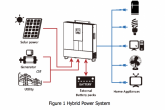La Ponderosa Colombia
New Member
- Joined
- Feb 29, 2020
- Messages
- 6
Hello all,
I’m new to this forum as well as Solar Energy. I am in the process of designing & building an off-grid hostel on the north coast of Colombia which is in a remote location with a lot of open space ideal for solar panels.
I’m planning to open with a capacity of 20-30 people with a view to expand in the future. I have been calculating the predicted daily kWh consumption, I’ve decided to power the oven/stoves/grill with gas as these are high consumers of kw, we plan to create a bio-digester to create our own gas down the line. My daily kWh predictions are:
Total: 25.2 kWh
Consumption during daylight: 12.2 kWh
Consumption during the night (battery): 13 kWh
Given 13 kWh capacity with batteries is expensive I’m considering powering the security system and fridges/freezers with their own small solar set ups. Excluding these, this would take the daily kWh consumption to:
Total: 16.6 kWh
Consumption during daylight: 9.4 kWh
Consumption during the night (battery): 7.2 kWh
The system I am planning is:
5 kw 48v MPP Inverter/controller
5 kw total of panels
6 24v 50amp Battle Born LiFePo4 batteries (7.2kw)
With 7.5 hours a day of sunlight, 5kw system, 80% efficiency, this should give 30 kWh a day.
I believe the kWh consumption in the night sometimes will be higher than my prediction. This would be greater than the 7.2kw battery capacity. To start with I don’t want to add an additional 24v 50amp battery due to the cost. I have a 5.5kw generator which I’ll use before I install a solar set up and I’ll use as a back up. The generator has an ‘Automatic Transfer Switch’ which connects to the grid. When the grid fails (in this region its a lot) it automatically connects to the generator. My thought is that in this instance the ‘grid’ would in fact be the solar set up. I plan to connect the generator to the inverter as in the diagram below. I have a few questions for this connection/series of events. I see it as follows:

I’m new to this forum as well as Solar Energy. I am in the process of designing & building an off-grid hostel on the north coast of Colombia which is in a remote location with a lot of open space ideal for solar panels.
I’m planning to open with a capacity of 20-30 people with a view to expand in the future. I have been calculating the predicted daily kWh consumption, I’ve decided to power the oven/stoves/grill with gas as these are high consumers of kw, we plan to create a bio-digester to create our own gas down the line. My daily kWh predictions are:
Total: 25.2 kWh
Consumption during daylight: 12.2 kWh
Consumption during the night (battery): 13 kWh
Given 13 kWh capacity with batteries is expensive I’m considering powering the security system and fridges/freezers with their own small solar set ups. Excluding these, this would take the daily kWh consumption to:
Total: 16.6 kWh
Consumption during daylight: 9.4 kWh
Consumption during the night (battery): 7.2 kWh
The system I am planning is:
5 kw 48v MPP Inverter/controller
5 kw total of panels
6 24v 50amp Battle Born LiFePo4 batteries (7.2kw)
With 7.5 hours a day of sunlight, 5kw system, 80% efficiency, this should give 30 kWh a day.
I believe the kWh consumption in the night sometimes will be higher than my prediction. This would be greater than the 7.2kw battery capacity. To start with I don’t want to add an additional 24v 50amp battery due to the cost. I have a 5.5kw generator which I’ll use before I install a solar set up and I’ll use as a back up. The generator has an ‘Automatic Transfer Switch’ which connects to the grid. When the grid fails (in this region its a lot) it automatically connects to the generator. My thought is that in this instance the ‘grid’ would in fact be the solar set up. I plan to connect the generator to the inverter as in the diagram below. I have a few questions for this connection/series of events. I see it as follows:

- Solar Panels provide power to the AC Output & batteries
- In the night the batteries will power the AC Output
- In an event the consumption is >7.2kw battery capacity, the battery discharges and the battery voltage drops to low DC warning voltage or setting point
- Either the stopping of the power from the battery triggers the ‘Automatic Transfer Switch’ on the generator and this turns on, or the MPP Inverter switches to the generator (I need to confirm if the inverter and generator are compatible to automatically make this switch or if it will be manual)
- Generator charges the batteries & AC output
- Is there a setting on the MPP Inverter which when the batteries are fully charged from the generator, the generator is turned off and the AC output switches back to being powered by the batteries?
- From your experience, does this general set up/calculations sound accurate?
- What level of discharge is advisable for LiFePo4 batteries?
- Does the generator automatically turn on when the batteries are low or does this need to be manual?
- When does the MPP inverter switch back to using the charged batteries rather than the generator?
- Does anyone have advice/experience with solar power fridges/freezers & security cameras?
- We have a large site, is it an issue that the MPP inverter could be 200 meters from the majority of the solar panels & some appliances using the AC Output will be 200 meters from the MMP Inverter?



